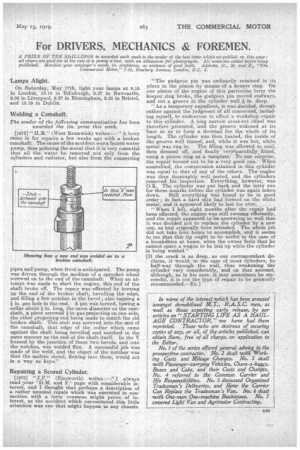For DRIVERS, MECHANICS & FOREMEN.
Page 21

If you've noticed an error in this article please click here to report it so we can fix it.
tamps Alight.
On Saturday, May 17th, light your lamps at 9.15 in London, 10.18 in Edinburgh, 9.37 in Newcastle, 9.36 in Liverpool, 9.27 in Birmingham, 9.25 in Bristol, and 10.19 in Dublin.
Welding a Camshaft.
The sender of the following communication has been awarded the los. prise this week.
[1974" H.M." (West Bromwich) writes :—" A lorry came in for repairs a few weeks ago with a broken camshaft. The cause of the accident was a frozen water pump, thus pointing the moral that it is very essential that all the water be removed not only from the cylinders and radiator, but also from the connecting pipes and pump, when frost is anticipated. The pump was driven through the medium of a sprocket wheel screwed on to the end of the.. camshaft. When an attempt was made to start the engine, this end of the shaft broke off. The repair was effected by turning up the end of the broken shaft, bevelling the edge, and filling a few notches in the bevel ; also tapping a in. gas hole in the end. A pin was turned, having a collar about in. long, the same diameter as the camshaft, a piece screwed in. gas projecting on one side, the other projecting end being made to match the old broken shaft. This stub was screwed into the end of the camshaft, that edge of the collar which came against the shaft being bevelled and notched in the same manner as the end of the shaft itself. In the V. formed by the junction of these two bevels, and into the notches, was welded flux. A successful job was made of the weld, and the object of the notches-was that the molten metal, flowing into them, would act in a way as keys."
Repairing a Scored Cylinder.
[1973] ",LP." (Einswortla) writes :—" I always read your DM. and F.' page with considerable interest, and I thought that perhaps a description of a rather unusual repair which was executed in connection with a lorry overseas might prove of interest, as the accident which necessitated this little attention was one that might happen to any chassis. "The gudgeon pin was ordinarily retained in its place in the piston by means of a keeper ring. On one piston of the engine of this particular lorry the keeper ring broke, the gudgeon pin moved endways, and cut a groove in the cylinder wall * in. deep.
"As a temporary expedient, it was decided, though rather against the judgment of all concerned, including myself, to endeavour to effect a workshop repair to this cylinder. A long narrow cross-cut chisel was therefore procured, and the groove widened at its base so as to form a dovetail for the whole of its length. The cylinder was then heated, the inside of the groove well tinned, and, while it was hot, white metal was run in. The filling was allowed to cool, then dressed off, and finally verAearefully, fitted, using a piston ring as a template. To our surprise, the repair turned out to be a very good one. When assembled, the compression attained in this. cylinder was equal to that of any of the others.. The engine was then thoroughly well tested, and the cylinders removed for, inspection. Everything, however, was O.K. The cylinder was put back and the lorry ru a for three months before the cylinder was again taken down. Still everything was found to be in good order ; in fact a. hard skin had formed on the white metal, and it appeared likely to last for ever.
"When I left, eight months after the repair had been effected, the engine was still running efficiently, ,and the repair appeared to be answering so well that it was decided not to replace the cylinder by a new one, as had originally been intended. The whole job did not take four hours to accomplish, and it seems to me that this tip ought to be useful in the case of a .breakdown at home, when the owner feels that he cannot spare a wagon to be laid up while the cylinder is being welded."
[If the crack is as deep, as our correspondent de clares, it would, in the case of most cylinders, be half-way through the wall, thus weakening the cylinder very considerably, and on that account, i although, as n his case, it, may sometimes be successful, it is not the type of repair to be generally recommencled.—En.]






















